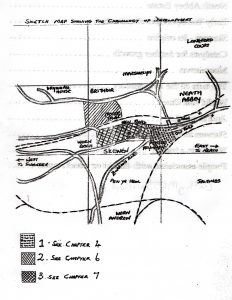Report from October Meeting of Resolfen History Society

The History of Skewen
This month’s speaker hardly needed an introduction since former Neath College lecturer, Mrs Carole Wilsher has been a resident of the Forest Lodge in Glynneath Road for thirty seven years. However, despite being well on her way to gaining her permanent -residency in Resolven, she described herself as being “Skewen through and through”.
She began her talk by given a brief account of why she had undertaken the work of producing a book on the history of her home village. The chief motive was the increasing march of globalisation in the modern world which was fast erasing the folk memories and even the buildings that had given rise to settlements in general. At first, her family were sceptical as to why she wanted to embark on such an epic journey, but this was justified by her realisation that her entire family, back to her great grandparents had emanated from the Skewen area. She praised the contribution of Gareth Richards, former proprietor of Gwasg Morgannwg in Skewen, for his encouragement and practical help in her endeavour. She started the work with an attempt to interpret the history of Skewen, by analysing the street names of the village, but failed when she realised that this called for some more serious research. The fruit of which was her book on the history of Skewen.
The story began with a look at the background to the development of the Skewen area. In 1129, the Cistercians at Neath Abbey were granted lands amounting to ten square miles in order to clear and manage, a process known as “assarting” in Old English. The work of the monks can be seen today in the prefix “cwrt” or grange(self-sufficient farms) which are still evident in local place names. In the Skewen area many names included ‘cwrt’for example ,Cwrt-y –Betws; Cwrt -y – Clafdy; Cwrt Herbert; and Cwrt Sart ( in Briton Ferry) is a corruption of “assart”. (And of course, Melincwrt in the Resolven area, referring to a mill. Ed.)
In the 1600s, the now dissolved monastery was acquired by the Hobby family and later bought by Lord Dynevor. Parcels of land were leased for the use of both industry and the concurrent agricultural revolution. In 1801, the famous Neath Abbey Ironworks was established in the Skewen area, and copper works were situated along the river Neath. Another catalyst in the development of the settlement was the building of the Tennant Canal by George Tennant (1821) which took products to the docks at Swansea (Port Tennant). However, the first embers of a sizable settlement came with the opening of the new turnpike road in 1830 to Swansea. This now forms the main thoroughfare through Skewen, as against the “old road”, which runs now to Llandarcy passing the Abbey.
It is difficult to give an exact date to the birth of Skewen, however, Mrs Wilsher showed that the area was almost exclusivel y farmland in 1770, however in 1816 a newspaper report on a robbery refers to the area as “Skewen Hill”, for the first time. By 1801, Coedffranc Parish ( still the name of the community council, Ed.) had some 50 scattered dwellings and in the 1811 census the area had 454 residents. The important aspect here is that instead of individual holdings, houses were now being built in clusters, surrounding industrial enterprises alongside the existing tracks on Skewen Hill, especially around the Crown Copper Works (There is a Crown public house to this day, Ed.). An estate map of 1838, shows that commercial premises were also being established in Skewen, and Mrs Wilsher noted that her family were residents at that time. Living conditions were squalid and epidemics of cholera (1840s), smallpox (1872) and Scarlet Fever (1890) were endemic. By 1871, Skewen was firmly established as a community with 2,500 residents.
The next period of development surrounded the coal industry and the main railway line. Edward Ackland Moore and his son ( brother in law of Neath entrepreneur Howel Gwyn) bought and ran a large colliery at Cwrt Herbert. In addition, large railway sidings were built nearby in order to transport the coal via Birchgrove to Swansea. They also acquired the Cwmdu estate in Skewen, but changed the name of the emerging settlement to Mooretown, which gave rise to a nascent” upper” as against “lower”, Skewen. This is a distinction which persists to this day. All Saints Church was built at this time.
The dawn of the twentieth century saw a massive boom in the population of the village, with the population in 1901 standing at 5, 410, this increased exponentially to 8,125 by the next census of 1911. The reason for the explosion is obvious since the Main Colliery Company had opened two new pits in Skewen , in 1903 and 1904. New houses were built for the workers along Dynevor Road ( formerly Coronation Road) , thus joining upper and lower Skewen for the first time. The streets were built on a typical grid pattern and organised by the Coombe- Tennant family, indeed Stanley Road refers to the famous H.M.Stanley ( a friend of the family) and Christopher Road is a son of the Coombe-Tennants. However, this blossoming development came to a crashing halt with the outbreak of the Great War in 1914. The Skewen collieries failed to gain an Admiralty contract for their coal which sent them into permanent decline, closing in the early 1920s. Another unwelcome guest at the time was the Spanish flu which decimated the population.
The saviour of Skewen without doubt was the coming of a large oil refinery in 1920 to nearby Llandarcy. This undoubtedly saved the village economically, and it was considered one of the wealthiest settlements in Wales because of the 3,000 well paid and varied jobs which came from the refinery. This is noticeable in the prevalence of mainly 30s style detached and semi-detached houses along Crumlin Road and Wern Road. The vast Skewen Park was established alongside the nine acres of Tennant Park. The Ritz cinema opened along with a dog track for racing and other notable buildings. The Refinery was a target during the second world war but mercifully was not badly bombed.
After the war, a period of council housing saw one hundred and fifty new houses in Skewen and also a move to clear the derelict land was undergone by Coedffranc Community Council following the Aberfan disaster of the mid-1960s. Another development was the setting up of new private estates following the closure of Llandarcy . Indeed, the only two original shops which are left are the Italian café run since the early twentieth century by the Cresci family and the Jeffreys Stores ( now Arborne) which was opened by a Jewish family. With a population of 8,500, Skewen is recognised as the largest village in Wales if not the UK.
Following a lively question and answer session, Mr Gwyn Thomas thanked Mrs Wilsher for a memorable evening.
(All proceeds from the book are donated to theTŷ Olwen Hospice, and remaining copies are still available from Mrs Wilsher at a cost of £12).
REPORT by Trefor Jones


